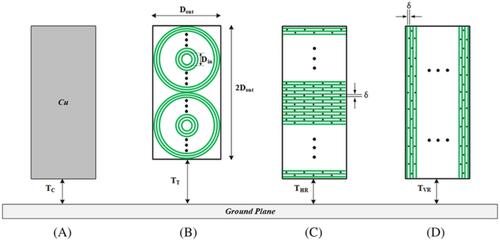当前位置:
X-MOL 学术
›
Int. J. Circ. Theory Appl.
›
论文详情
Our official English website, www.x-mol.net, welcomes your
feedback! (Note: you will need to create a separate account there.)
A comprehensive comparative study of the performance of carbon- and copper-based interconnects in ultra-large-scale integrated circuits
International Journal of Circuit Theory and Applications ( IF 1.8 ) Pub Date : 2021-05-13 , DOI: 10.1002/cta.3049 Majid Sanaeepur 1 , Ali Mahmoudi 1
International Journal of Circuit Theory and Applications ( IF 1.8 ) Pub Date : 2021-05-13 , DOI: 10.1002/cta.3049 Majid Sanaeepur 1 , Ali Mahmoudi 1
Affiliation

|
Continuous increase of transistor count in ultra-large-scale integrated (ULSI) circuits demands denser interconnection networks to guarantee normal operation. As the distances between adjacent interconnect lines shrinks, severe crosstalk effects appear. New interconnect materials and technologies are proposed to alleviate deteriorating crosstalk effects and maintain overall circuit performance at a desirable level. Carbon-based materials including carbon nanotubes (CNTs) and graphene nanoribbons (GNRs) are among promising candidate materials to replace copper in future ULSI interconnects. In this work, carbon-based interconnects including multiwall carbon nanotubes (MWCNTs) and multilayer graphene nanoribbons (MLGNRs), both horizontal (HMLGNRs) and vertical (VMLGNRs), are compared with traditional copper interconnects in terms of crosstalk delay and noise. Due to lower surface roughness, boron nitride (BN) is considered as substrate material for carbon-based interconnects. To obtain more accurate and reliable results, layer number dependence of dielectric constant of BN multilayers and surface roughness dependence of the resistivity of HMLGNR interconnects are considered. The role of interconnect length, line spacing, and interlayer distance (substrate thickness) in crosstalk delay and noise of coupled carbon- and Cu-based interconnect lines is investigated. It is shown that VMLGNR interconnects with perfect GNR edges exhibit the least crosstalk delay while MWCNT interconnects show far less crosstalk noise than other materials.
中文翻译:

超大规模集成电路中碳基和铜基互连性能的综合比较研究
超大规模集成 (ULSI) 电路中晶体管数量的不断增加需要更密集的互连网络来保证正常运行。随着相邻互连线之间距离的缩小,会出现严重的串扰效应。提出了新的互连材料和技术来减轻不断恶化的串扰效应并将整体电路性能保持在理想的水平。包括碳纳米管 (CNT) 和石墨烯纳米带 (GNR) 在内的碳基材料是未来 ULSI 互连中替代铜的有前途的候选材料之一。在这项工作中,碳基互连包括多壁碳纳米管 (MWCNTs) 和多层石墨烯纳米带 (MLGNRs),水平 (HMLGNRs) 和垂直 (VMLGNRs),在串扰延迟和噪声方面与传统的铜互连进行比较。由于较低的表面粗糙度,氮化硼 (BN) 被认为是碳基互连的基板材料。为了获得更准确和可靠的结果,需要考虑 BN 多层膜介电常数的层数依赖性和 HMLGNR 互连电阻率的表面粗糙度依赖性。研究了互连长度、线间距和层间距离(衬底厚度)在耦合碳基和铜基互连线的串扰延迟和噪声中的作用。结果表明,具有完美 GNR 边缘的 VMLGNR 互连表现出最小的串扰延迟,而 MWCNT 互连的串扰噪声远小于其他材料。氮化硼 (BN) 被认为是碳基互连的衬底材料。为了获得更准确和可靠的结果,需要考虑 BN 多层膜介电常数的层数依赖性和 HMLGNR 互连电阻率的表面粗糙度依赖性。研究了互连长度、线间距和层间距离(衬底厚度)在耦合碳基和铜基互连线的串扰延迟和噪声中的作用。结果表明,具有完美 GNR 边缘的 VMLGNR 互连表现出最小的串扰延迟,而 MWCNT 互连的串扰噪声远小于其他材料。氮化硼 (BN) 被认为是碳基互连的衬底材料。为了获得更准确和可靠的结果,需要考虑 BN 多层膜介电常数的层数依赖性和 HMLGNR 互连电阻率的表面粗糙度依赖性。研究了互连长度、线间距和层间距离(衬底厚度)在耦合碳基和铜基互连线的串扰延迟和噪声中的作用。结果表明,具有完美 GNR 边缘的 VMLGNR 互连表现出最小的串扰延迟,而 MWCNT 互连的串扰噪声远小于其他材料。考虑了 BN 多层膜的介电常数的层数依赖性和 HMLGNR 互连电阻率的表面粗糙度依赖性。研究了互连长度、线间距和层间距离(衬底厚度)在耦合碳基和铜基互连线的串扰延迟和噪声中的作用。结果表明,具有完美 GNR 边缘的 VMLGNR 互连表现出最小的串扰延迟,而 MWCNT 互连的串扰噪声远小于其他材料。考虑了 BN 多层膜的介电常数的层数依赖性和 HMLGNR 互连电阻率的表面粗糙度依赖性。研究了互连长度、线间距和层间距离(衬底厚度)在耦合碳基和铜基互连线的串扰延迟和噪声中的作用。结果表明,具有完美 GNR 边缘的 VMLGNR 互连表现出最小的串扰延迟,而 MWCNT 互连的串扰噪声远小于其他材料。
更新日期:2021-05-13
中文翻译:

超大规模集成电路中碳基和铜基互连性能的综合比较研究
超大规模集成 (ULSI) 电路中晶体管数量的不断增加需要更密集的互连网络来保证正常运行。随着相邻互连线之间距离的缩小,会出现严重的串扰效应。提出了新的互连材料和技术来减轻不断恶化的串扰效应并将整体电路性能保持在理想的水平。包括碳纳米管 (CNT) 和石墨烯纳米带 (GNR) 在内的碳基材料是未来 ULSI 互连中替代铜的有前途的候选材料之一。在这项工作中,碳基互连包括多壁碳纳米管 (MWCNTs) 和多层石墨烯纳米带 (MLGNRs),水平 (HMLGNRs) 和垂直 (VMLGNRs),在串扰延迟和噪声方面与传统的铜互连进行比较。由于较低的表面粗糙度,氮化硼 (BN) 被认为是碳基互连的基板材料。为了获得更准确和可靠的结果,需要考虑 BN 多层膜介电常数的层数依赖性和 HMLGNR 互连电阻率的表面粗糙度依赖性。研究了互连长度、线间距和层间距离(衬底厚度)在耦合碳基和铜基互连线的串扰延迟和噪声中的作用。结果表明,具有完美 GNR 边缘的 VMLGNR 互连表现出最小的串扰延迟,而 MWCNT 互连的串扰噪声远小于其他材料。氮化硼 (BN) 被认为是碳基互连的衬底材料。为了获得更准确和可靠的结果,需要考虑 BN 多层膜介电常数的层数依赖性和 HMLGNR 互连电阻率的表面粗糙度依赖性。研究了互连长度、线间距和层间距离(衬底厚度)在耦合碳基和铜基互连线的串扰延迟和噪声中的作用。结果表明,具有完美 GNR 边缘的 VMLGNR 互连表现出最小的串扰延迟,而 MWCNT 互连的串扰噪声远小于其他材料。氮化硼 (BN) 被认为是碳基互连的衬底材料。为了获得更准确和可靠的结果,需要考虑 BN 多层膜介电常数的层数依赖性和 HMLGNR 互连电阻率的表面粗糙度依赖性。研究了互连长度、线间距和层间距离(衬底厚度)在耦合碳基和铜基互连线的串扰延迟和噪声中的作用。结果表明,具有完美 GNR 边缘的 VMLGNR 互连表现出最小的串扰延迟,而 MWCNT 互连的串扰噪声远小于其他材料。考虑了 BN 多层膜的介电常数的层数依赖性和 HMLGNR 互连电阻率的表面粗糙度依赖性。研究了互连长度、线间距和层间距离(衬底厚度)在耦合碳基和铜基互连线的串扰延迟和噪声中的作用。结果表明,具有完美 GNR 边缘的 VMLGNR 互连表现出最小的串扰延迟,而 MWCNT 互连的串扰噪声远小于其他材料。考虑了 BN 多层膜的介电常数的层数依赖性和 HMLGNR 互连电阻率的表面粗糙度依赖性。研究了互连长度、线间距和层间距离(衬底厚度)在耦合碳基和铜基互连线的串扰延迟和噪声中的作用。结果表明,具有完美 GNR 边缘的 VMLGNR 互连表现出最小的串扰延迟,而 MWCNT 互连的串扰噪声远小于其他材料。











































 京公网安备 11010802027423号
京公网安备 11010802027423号